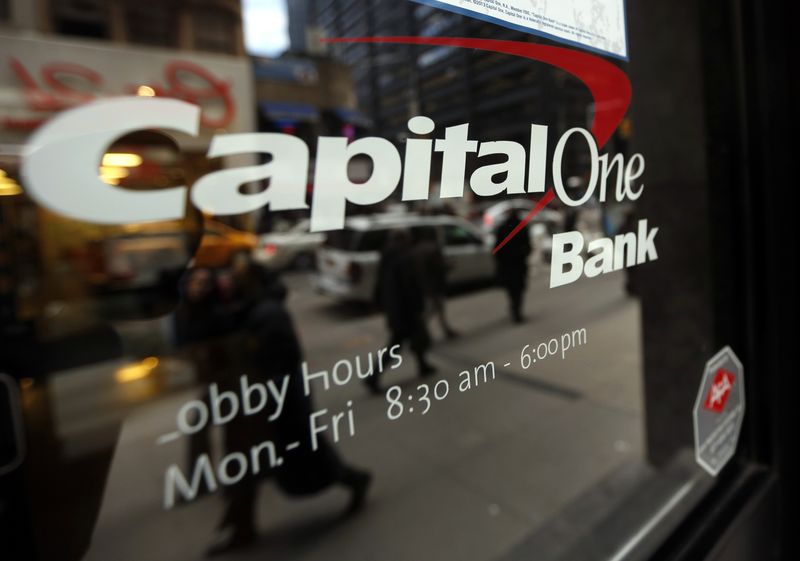By Nupur Anand and Koh Gui Qing
NEW YORK (Reuters) -For months, consumers have clamored for banks to pay out more for deposits as the Federal Reserve raised interest rates. Now analysts say after the banking crisis shook markets last month, lenders appear to be rejigging offers in an effort to keep customers' cash parked in their accounts for longer.
U.S. banks are trying to woo depositors by offering signing bonuses to open new accounts or deposit money on a regular basis. The promotions are running at a time when the failures of Silicon Valley Bank (SVB) and Signature Bank (OTC:SBNY) last month spooked customers, prompting them to move $119 billion out of smaller institutions.
Capital One Financial Corp (NYSE:COF) is advertising a $100 bonus for opening a new savings account and keeping more than $10,000 in it for 90 days. The offer ramps up to a bonus of $1,000 for deposits of over $100,000.
Discover Financial Services (NYSE:DFS) and LendingClub (NYSE:LC) are offering similar perks, which were in effect before the bank runs began.
A Capital One spokesperson said the campaign is part of their longstanding strategy to help customers build balances in their savings accounts, and had been planned for several months.
Citizens Financial (NYSE:CFG) Group is offering a $25 bonus for customers who put in $100 a month for three months and maintaining a minimum balance, according to emails sent to customers after March 10.
The offer is part of a pre-planned campaign to promote healthy savings habits, and not in reaction to specific events, Citizens spokeswoman Eleni Garbis said in a statement.
Discover did not immediately respond to requests for comment.
Paying more for deposits is an effective way for banks to keep customers loyal, analysts said.
"As rates have risen, high-yield savings accounts have become fashionable once again, with some banks competing aggressively to stay at the top of the rate tables that consumers rely on for comparison purposes," said Andrew Davidson, chief insights officer at Mintel, a market intelligence agency.
"The intense competition has been further fueled by an overall drop in deposits, with more firms reaching out to customer in the last few weeks," he added.
Banks are also trying to retain customers by employing other techniques such as explaining to customers the rules around deposit insurance, offering different products or emphasizing ties to local communities.
Smaller banks, which were most strained by the recent crisis, have been able to stem the exodus of deposits for now, according to weekly data from the Federal Reserve. But industry experts continue to monitor the outflows closely.
DEPOSIT OUTFLOW STABILIZING
The Fed’s data showed smaller U.S. banks -- defined as any lender that is not among the largest 25 U.S. banks ranked by assets -- saw their deposits stabilize in the week of March 22, down just $1.1 billion from the previous week on a non-seasonally adjusted basis.
That compares with $185 billion of deposits that were yanked out of smaller lenders by panicked customers during the week ending March 15, after SVB collapsed. That said, the Fed’s data showed deposits at smaller banks were still down some $216 billion during the week ending March 22 from a December high.
The Independent Community Bankers (NASDAQ:ESXB) of America, an industry group, said some of its members had actually gained deposits in recent weeks as consumers and small businesses sought out banks with strong ties to their local markets.
“Community banks have not reported widespread withdrawals in response to the SVB failure," said Anne Balcer, senior executive vice president, chief of government relations and public policy at the ICBA.
"Main Street community banks are there for their customers during uncertain times and have proven to be resilient through economic cycles."
Meanwhile, large U.S. banks lost out on $96.2 billion in deposits in the week ending March 22, the Fed data showed. Several analysts attributed to decline to depositors moving their cash to higher-yielding money market funds.
Deposits at large banks dropped some $519 billion from as high as $11.2 trillion in February last year.

Banks act as middlemen in the economy by taking deposits and making loans. So far, the decline in deposits hasn't stopped them from extending credit to households and businesses.
“Tighter funding conditions for banks have not translated into any notable deceleration in aggregate U.S. banking sector loan growth relative to February levels,” analysts at Moody’s Investors Service said in a note.